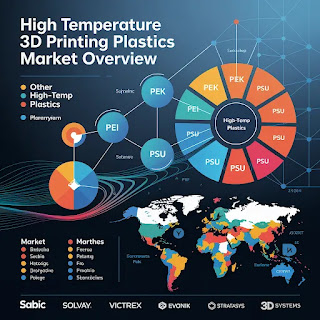The High Temperature 3D Printing Plastics Market: Revolutionizing Manufacturing with Superior Materials
The high
temperature 3D printing plastics market is experiencing unprecedented
growth, driven by increasing demand for advanced materials capable of
withstanding extreme conditions. The global high temperature 3D printing
plastics market size was valued at USD 795.15 million in 2023 and is projected
to grow at a CAGR of 13.3% from 2024 to 2030, demonstrating the strong momentum
behind this specialized segment of additive manufacturing.
Explore the full report on - https://futuremarketanalytics.com/report/high-temperature-3d-printing-plastics-market/
What Are High Temperature 3D Printing Plastics?
High temperature 3D printing plastics are specialized
materials engineered to maintain their structural integrity and performance
characteristics at elevated temperatures, often exceeding 200°C during
processing and maintaining functionality at operating temperatures well above
conventional thermoplastics. The most prominent materials in this category
include polyetheretherketone (PEEK), polyetherimide (PEI, commonly known as
ULTEM), and polyphenylsulfone (PPSU).
Known for its exceptional thermal stability, mechanical
properties, and chemical resistance, PEEK is often the material of choice in
industries like aerospace, automotive, and medical. These materials require
specialized high-temperature 3D printers equipped with heated chambers and
advanced extruder systems capable of reaching processing temperatures of 400°C
or higher.
Market Drivers and Growth Factors
The remarkable growth trajectory of the high temperature 3D
printing plastics market stems from several key factors. The aerospace industry
leads demand, where weight reduction and performance under extreme conditions
are critical. The properties of ULTEM 9085 make it an ideal for aerospace and
automotive applications, providing high-performance parts and a lightweight
alternative to metal.
The automotive sector is another major driver, as
manufacturers seek to replace traditional metal components with lighter,
corrosion-resistant alternatives that can withstand engine compartment
temperatures. Medical applications are also expanding rapidly, particularly for
surgical instruments and implantable devices where biocompatibility and
sterilization resistance are essential.
Industrial manufacturing increasingly recognizes the value
of producing end-use parts directly through additive manufacturing, eliminating
traditional tooling requirements and enabling complex geometries impossible
with conventional manufacturing methods.
Key Applications and Industries
PEEK typical applications include elements of machines and
devices in automotive, marine, nuclear, oil-well, electronics, medical, and
aerospace industries. The versatility of high temperature plastics extends
across numerous sectors, each leveraging unique material properties.
In aerospace, these materials produce lightweight interior
components, ductwork, and electrical enclosures that must withstand cabin
pressurization cycles and temperature extremes. The automotive industry
utilizes them for under-hood applications, fuel system components, and
lightweight structural elements that contribute to improved fuel efficiency.
The medical sector benefits from the biocompatibility and
sterilization resistance of materials like PEEK, enabling production of custom
implants, surgical instruments, and diagnostic equipment components. Oil and
gas applications leverage their chemical resistance and high-temperature
performance for downhole tools and pipeline components.
Technological Advancements and Equipment
The success of high temperature 3D printing depends heavily
on specialized equipment capable of handling the extreme processing
requirements. PEEK and PEI materials resist heat, water, pressure, and more but
require a PEEK and PEI 3D printer that generates a high degree of heat to be
used properly.
Modern high-temperature 3D printers feature heated chambers
maintaining ambient temperatures of 200°C or higher, advanced extruder systems
reaching 450°C, and precise temperature control throughout the build volume.
These machines bridge the gap between desktop prototyping systems and full
industrial manufacturing equipment.
Market Challenges and Future Outlook
Despite strong growth prospects, the high temperature 3D
printing plastics market faces several challenges. Material costs remain
significantly higher than conventional 3D printing filaments, and the
specialized equipment required represents substantial capital investment.
Technical expertise requirements for successful processing also limit adoption
among smaller manufacturers.
However, ongoing research into material formulations and
processing techniques continues to address these barriers. New polymer blends
are being developed to improve printability while maintaining high-performance
characteristics, and equipment manufacturers are working to reduce system
complexity and costs.
The market outlook remains highly positive, with expanding
applications across traditional industries and emerging sectors recognizing the
unique advantages of high temperature additive manufacturing. As material costs
decrease and processing technology advances, adoption is expected to accelerate
significantly over the next decade, positioning high temperature 3D printing
plastics as a cornerstone of advanced manufacturing strategies.




Comments
Post a Comment